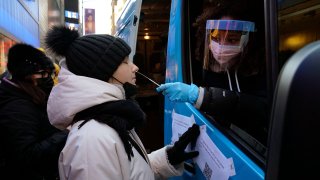
- The updated guidance comes after the CDC faced criticism last week for shortening its recommended isolation period without asking for people to get tested.
- The CDC said people are most contagious two days prior to symptom onset and about three days afterward.
- Dr. Rochelle Walensky, the CDC's director, said during a White House Covid update last week that up to 90% of transmission happens during that period.
The U.S. Centers for Disease Control and Prevention amended its controversial Covid-19 isolation guidance on Tuesday, declining to add a testing requirement as public health officials expected after the agency cut its recommended quarantine time in half.
In its updated guidance, the CDC said people who have recovered from the virus and have isolated for at least five days can take a rapid test if they want, but they don't have to — falling far short of making an outright recommendation to get a negative Covid test before ending isolation.
Get top local stories in San Diego delivered to you every morning. >Sign up for NBC San Diego's News Headlines newsletter.
"I do not think that the clarification helped at all and I actually think that it made things worse," emergency physician Dr. Leanna Wen, the former health commissioner of Baltimore, said in an interview with CNN. "I think they should be upfront and say they can't do this because they don't have enough tests."
The updated guidance comes after the CDC faced a barrage of criticism last week for shortening its recommended isolation period from 10 days without asking for people to get tested.
"If an individual has access to a test and wants to test, the best approach is to use an antigen test towards the end of the 5-day isolation period," the agency said in updated guidance on its website.
Money Report
Many Americans do not have access to tests right now. Pharmacies are frequently sold out of at-home tests both online and in stores amid a dramatic spike in demand, and lines at testing sites are often hourslong.
The CDC, in its guidance, recommended that people with Covid isolate for five days if they are asymptomatic or if their symptoms are resolving. They should then wear a mask for five days after coming out of isolation.
The CDC said people are most contagious two days prior to symptom onset and about three days afterward. CDC Director Dr. Rochelle Walensky said last week that up to 90% of transmission happens during that period.
Walensky said the CDC did not distinguish between people who are unvaccinated and vaccinated in its isolation guidance because transmission peaks at about the same time regardless of immunization status.
White House chief medical advisor Dr. Anthony Fauci, in an interview with CNN, said isolation guidelines were updated in part to address the sheer number of people forced to stay home from work due to infections from the highly contagious omicron variant.
The U.S. reported a pandemic record of more than 1 million new infections on Monday, according to data compiled by Johns Hopkins University. The nation is now reporting a seven-day average of more than 480,000 new infections, nearly double the week prior, according to a CNBC analysis of Hopkins data.
Walensky separately told CNN the new guidelines also reflect what the public is willing to tolerate. She noted that some data indicates less than a third of people are adhering to guidelines on isolation.
"We really want to make sure that we had guidance in this moment where we were going to have a lot of disease that could be adhered to, that people were willing to adhere to," Walensky told CNN.
Walensky, during the White House briefing last week, said the CDC did not ask people to get tested before leaving isolation because they can remain positive for up to 12 weeks after infection on a PCR test, long after they are no longer contagious. She said it's also not yet clear how effective antigen tests are at detecting transmissibility at day five.
The CDC also shortened its quarantine period for people who are exposed to Covid. People who have not received a booster should quarantine for five days if it has been longer than six months from their second Moderna or Pfizer shots, or longer than two months from their Johnson & Johnson dose. They should then wear a mask for five days after leaving quarantine. The unvaccinated should follow these same guidelines.
People who have received a booster do not need to quarantine, but should wear a mask for 10 days after exposure, according to the guidance.






